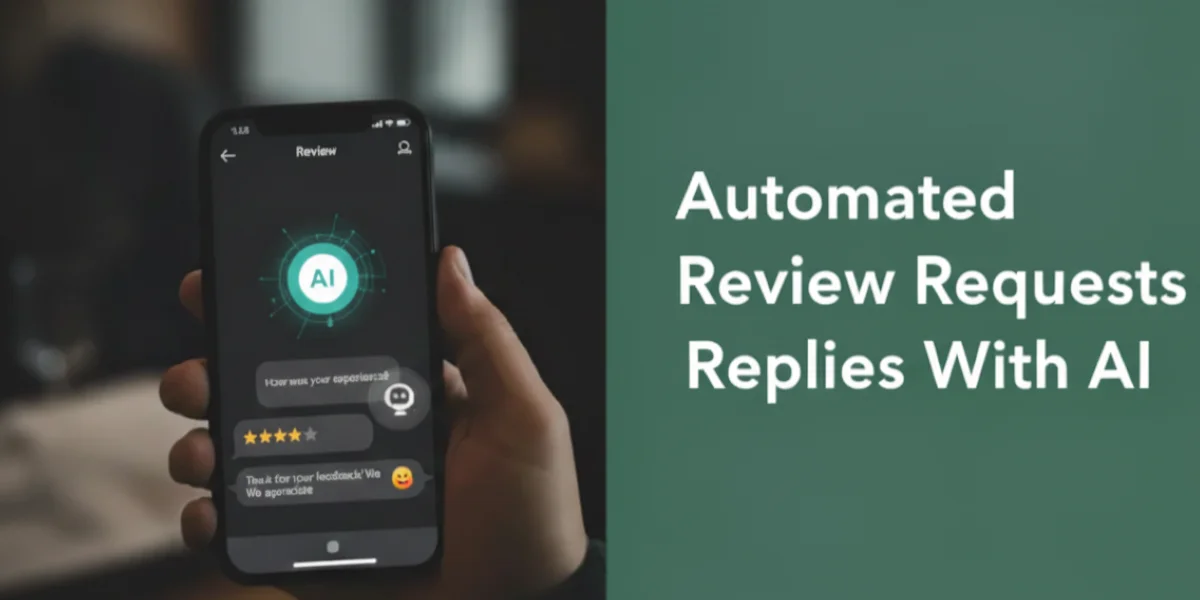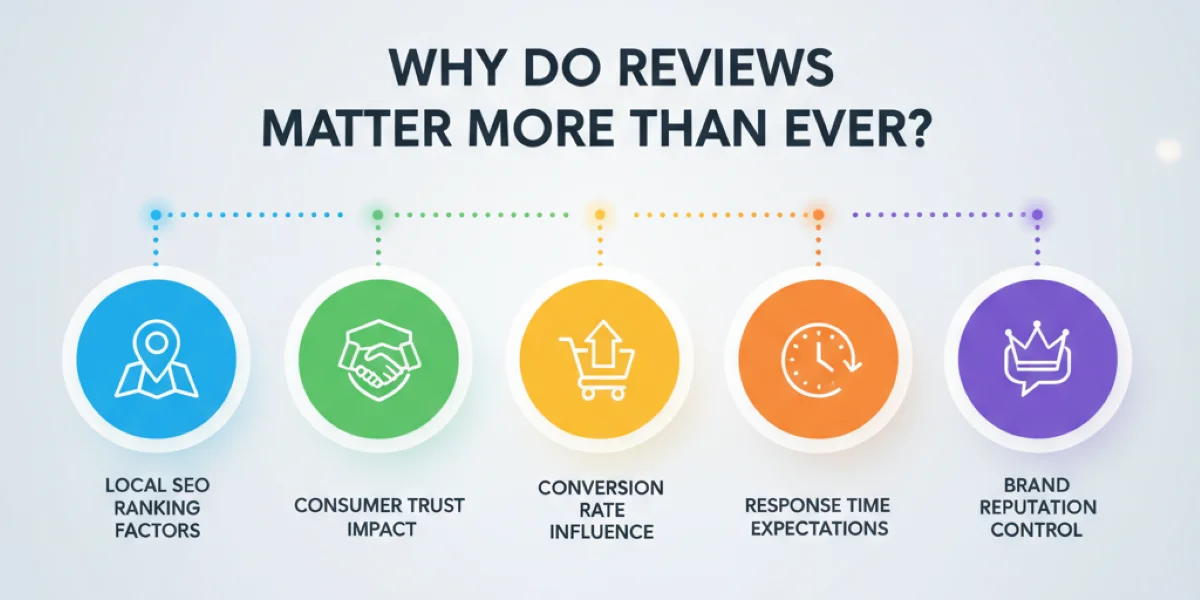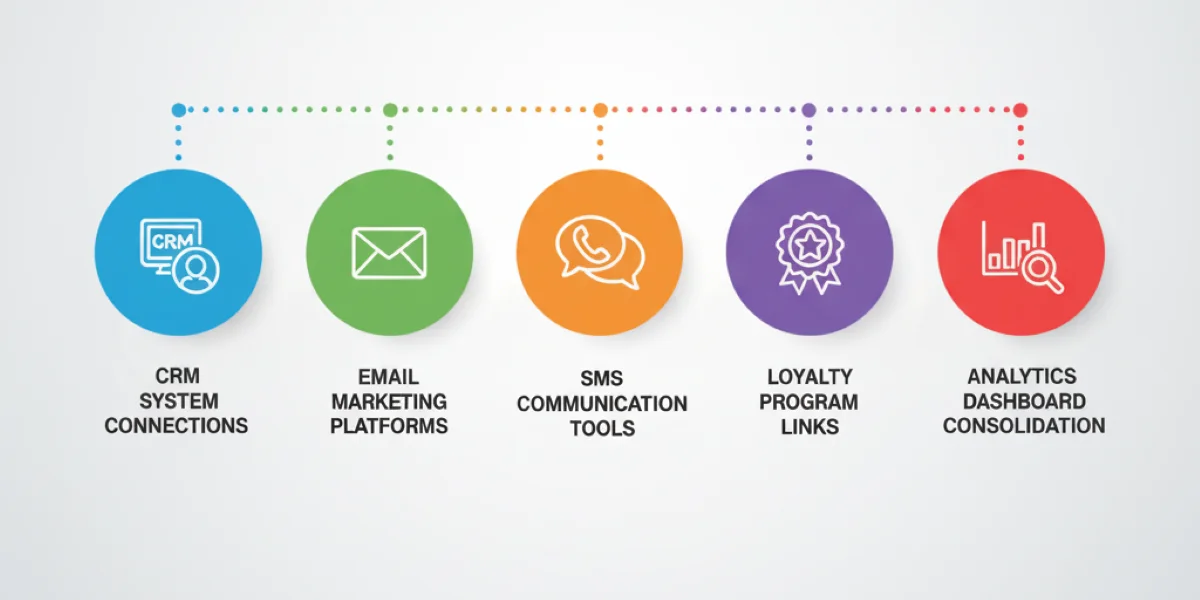
Customer reviews have become the backbone of business credibility in today’s digital marketplace. Every day, business owners face the challenge of managing countless review requests and responses while maintaining authentic connections with their customers. The pressure to respond quickly and personally can feel overwhelming, especially when your team is already stretched thin.
But here’s the reality: reviews influence 88% of customers in discovering and patronizing local businesses. This automated review requests and replies with AI solutions bridges the gap between efficiency and personalization, allowing businesses to scale their reputation management without sacrificing the human touch that customers value most.

The two pillars: review collection vs. review response

Effective review management requires mastering two distinct processes: systematically collecting feedback from satisfied customers and strategically responding to reviews across all platforms with consistency and authenticity.
Automated review requests
Automated systems trigger personalized review invitations at optimal moments, increasing response rates while reducing manual workload for busy teams managing numerous customer relationships across multiple locations simultaneously.
SMS and email triggers
SMS review requests boast a 97% open rate, making them highly effective for immediate responses. Email triggers work best for B2B contexts, while SMS excels for consumer-facing businesses requiring quick feedback collection.
Personalization tactics
Include customer names, specific purchase details, and service dates in requests to show genuine interest. Reference particular products or experiences rather than sending generic, automated messages that feel impersonal and transactional to recipients.
Optimal timing strategies
Send requests when satisfaction peaks, immediately after positive interactions, successful deliveries, or problem resolution moments. Timing directly impacts response rates and review positivity across all customer segments, maximizing feedback quality and quantity simultaneously.
CRM and POS integration
Connect review request systems with existing customer relationship management and point-of-sale platforms for seamless automation. Integration triggers requests based on transaction completion and customer interaction history, eliminating manual processes and reducing staff workload significantly.
Multi-channel approach
Deploy review requests across email, SMS, and in-app notifications to maximize reach. Different customer segments prefer different channels, so offering multiple touchpoints maximizes participation rates, feedback collection, and overall response volume for comprehensive insights.
Automated review replies
Strategic response automation ensures timely, brand-consistent replies while maintaining personalization that resonates with customers and prospects reading your review interactions across various platforms and channels consistently.
SEO benefits
Search engines favor businesses that actively engage with reviews on multiple platforms. Regular responses signal relevance and activity, improving local search rankings and increasing visibility in competitive markets, driving more organic traffic consistently.
Trust building
Public responses demonstrate accountability and customer care to potential buyers. Potential customers read your replies to gauge responsiveness, professionalism, and how you handle both praise and criticism, influencing their final purchasing decisions significantly.
Customer loyalty impact
Responding to reviewers strengthens relationships and encourages repeat business from satisfied customers. Customers who receive thoughtful replies feel valued and are more likely to return, recommend your business, and become long-term advocates publicly.
Response rate benchmarks
Industry-leading businesses maintain 90%+ response rates across all review platforms consistently. Automation helps achieve consistency and scale, while human oversight ensures quality in every interaction with current and prospective customers, maintaining brand standards always.
Platform-specific strategies
Google, Yelp, Facebook, and Trustpilot each have unique review ecosystems and audience expectations. Tailor response strategies to platform norms and audience expectations for maximum impact, engagement, and effectiveness across all digital touchpoints and channels.
Why do reviews matter more than ever?

Online reviews have evolved from nice-to-have testimonials into critical business assets that directly impact visibility, revenue, and long-term growth in competitive markets today.
Local SEO ranking factors
Reviews determine whether a business lands in the Google Map Pack, which represents the top three search engine results for local queries. Higher ratings and review volume improve visibility significantly.
Consumer trust impact
Modern consumers trust online reviews as much as personal recommendations from friends. Authentic customer feedback builds credibility faster than any marketing campaign, directly influencing purchasing decisions across all industries and demographics.
Conversion rate influence
Businesses with consistent positive reviews experience significantly higher conversion rates. Potential customers actively seek social proof before committing, making review management essential for closing sales and reducing customer acquisition costs effectively.
Response time expectations
Customers expect review responses within 24-48 hours. Delayed responses signal poor customer service and damage reputation, while prompt replies demonstrate attentiveness, professionalism, and a genuine commitment to customer satisfaction.
Brand reputation control
Active review management allows businesses to shape their online narrative effectively. Responding to both positive and negative feedback shows accountability and commitment to customer satisfaction across all touchpoints, building long-term trust and loyalty.
The human-in-the-loop framework
The recommended best practice is a human-in-the-loop workflow, where AI provides the foundation and a team member adds the final layer of brand personality and specific detail for authenticity.
AI-assisted review responses
AI analyzes reviews and generates contextually appropriate response drafts within seconds of publication. Human team members then review, refine, and approve before publication, ensuring authenticity, accuracy, and alignment with brand voice consistently across all platforms.
Workflow process steps
Reviews arrive and trigger AI sentiment analysis automatically. The system generates response drafts based on tone and content immediately. Designated team members receive notifications, edit for brand voice, and approve publication before responses go live publicly.
Approval threshold settings
Configure AI confidence levels to determine which responses need human review before publication. High-confidence positive reviews may auto-publish automatically, while negative or complex reviews always require manual approval and careful human oversight for quality.
Quality assurance gates
Establish review checkpoints before responses go live on public platforms. Include brand voice verification, factual accuracy checks, and compliance screening to maintain consistent quality across all customer interactions, protecting reputation and ensuring excellence always.
How does AI review automation actually work?
AI review systems combine natural language processing, sentiment analysis, and machine learning to understand context, generate appropriate responses, and continuously improve performance based on feedback and interaction data.
Sentiment analysis
AI categorizes reviews as positive, negative, or neutral by analyzing word choice, tone, and context carefully. This classification determines response templates and escalation protocols for different feedback types, ensuring appropriate handling of all customer sentiments consistently.
Natural language processing
NLP enables AI to understand nuanced meanings, sarcasm, and emotional undertones in customer feedback accurately. Systems parse complex sentences to identify specific praise, complaints, or suggestions within reviews, extracting actionable insights for businesses to address systematically.
AI response generation methods
Template-based systems use predefined structures with variable insertion for consistency. Generative AI creates unique responses from scratch using advanced algorithms. Hybrid approaches combine both methods for optimal balance between consistency, creativity, and personalization at scale.
Training AI systems
Feed AI your brand voice guidelines, common customer questions, product information, and sample approved responses regularly. Continuous training improves accuracy and ensures responses align with evolving business needs, maintaining quality standards and brand consistency across all interactions.
Platform integration capabilities
Modern AI tools connect with Google Business Profile, Yelp, Facebook, and industry-specific review platforms seamlessly. Unified dashboards centralize review management across all customer touchpoints for efficient monitoring, response coordination, and comprehensive performance tracking in real-time.
Best practices for automated review replies

Strategic response practices maximize customer engagement while maintaining authenticity across all platforms. Different review types require tailored approaches that balance automation efficiency with genuine human connection and personalized attention at all times.
Positive reviews
Positive feedback deserves enthusiastic, personalized acknowledgment that reinforces customer satisfaction, encourages continued advocacy, and strengthens emotional connections with your brand for long-term loyalty and repeat business opportunities.
- Thank customers by name and reference specific compliments from their review directly.
- Highlight particular aspects customers loved—menu items, staff members, or service elements they mentioned.
- Invite satisfied customers to return, try new offerings, or share experiences on social media platforms.
- Mention employees by name when customers praise specific staff members publicly.
- Vary language patterns, sentence structures, and expressions to prevent template fatigue and maintain authentic communication.
Negative reviews
Negative feedback requires empathetic, solution-focused responses that demonstrate accountability and commitment. Automation tools work well for positive reviews but fall short on negatives, meaning you will still have to pick up the slack manually.
- Acknowledge customer frustration without being defensive or dismissive of their concerns.
- Own legitimate mistakes transparently without making excuses or shifting blame.
- Provide specific remedies, refunds, replacements, or direct contact with management for resolution.
- Never argue publicly or blame customers for misunderstandings or issues.
- After the public response, reach out through direct channels to resolve issues thoroughly.
Neutral reviews
Three-star reviews represent improvement opportunities worth pursuing strategically. Strategic responses can convert fence-sitters into enthusiastic advocates who update ratings after positive follow-up, second chances, and demonstrated commitment to addressing their concerns.
- Thank reviewers for balanced perspectives and highlight the positive aspects they mentioned specifically.
- Respond specifically to the mentioned shortcomings without over-explaining or making excuses.
- Encourage neutral reviewers to contact you directly with additional feedback for detailed discussion.
- When reviewers mention common pain points, explain recent changes addressing those issues specifically.
- Politely invite customers to return and experience improvements firsthand with genuine enthusiasm.
Balancing personalization vs. efficiency
The best outcome comes from combining the speed of AI personalization tools and fact-checking capabilities of an actual human employee for optimal results across all customer interactions.
Avoiding robotic responses
Use AI-generated drafts as starting points, not final products for publication. Add conversational touches, humor when appropriate, and unique details that reflect your brand personality in every interaction, ensuring responses feel authentic and genuinely human.
Leveraging customer data
Integrate purchase history, service dates, and interaction records into response generation systems. Specific references to individual customer experiences create authentic, personalized replies at scale, demonstrating that you remember and value each customer’s unique relationship.
A/B testing strategies
Test AI-generated versus human-written responses to measure engagement differences systematically. Compare response templates against fully custom replies to optimize the efficiency-personalization balance for your audience, refining approaches based on performance data consistently.
Setting confidence levels
Configure AI systems to flag low-confidence responses for human review before publication. Establish thresholds based on sentiment complexity, review length, and mention of specific issues requiring careful handling, ensuring quality control and appropriate oversight always.
Quality control metrics
Closely monitor response edit rates. Frequent human modifications indicate AI training needs improvement. Track customer reactions to responses through follow-up ratings and engagement to continuously improve system performance, maintaining high standards and refining AI capabilities over time.
Automation traps to prevent

Even well-intentioned automation can damage a reputation when implemented carelessly or without oversight. Understanding common mistakes helps businesses maintain authenticity while scaling review management effectively, protecting brand reputation and customer relationships consistently.
Over-automation issues
Fully automated systems lack nuance for complex situations requiring human judgment. Reserve automation for straightforward scenarios and route sensitive, complicated, or escalated reviews to experienced human team members who can handle delicate situations with appropriate care.
Cultural and regional nuances
AI trained on generic datasets may miss local expressions, cultural sensitivities, or regional preferences. Customize systems for your specific markets to avoid tone-deaf responses that alienate customers, ensuring cultural appropriateness and regional relevance in all communications.
Template fatigue detection
When multiple reviews receive nearly identical responses, customers notice, and credibility suffers significantly. Regularly audit published responses and update AI training to maintain variety and authenticity, preventing repetitive patterns that undermine genuine engagement and trust.
Stale training data
AI performance degrades without fresh training inputs and updated information. Regularly update systems with new approved responses, changing products or services, and evolving brand voice to maintain response quality, ensuring AI reflects current business standards consistently.
Data privacy & compliance
Review automation systems that handle sensitive customer information, requiring strict adherence to privacy regulations consistently. Non-compliance risks substantial fines and irreparable reputation damage that can devastate businesses, making proper implementation essential for protection.
GDPR requirements
European customers have rights to data access, deletion, and portability under the law. Ensure AI systems can honor these requests promptly and maintain compliant data processing agreements with all vendors, protecting customer privacy and avoiding significant penalties.
CCPA compliance standards
California privacy laws mandate transparent data collection disclosures and opt-out mechanisms clearly. Review automation platforms must provide clear privacy notices and honor consumer data requests promptly, ensuring compliance with state regulations and protecting customer rights.
Customer consent protocols
Obtain explicit permission before sending automated review requests via SMS or email channels. Document consent mechanisms and maintain records demonstrating compliance with communication preference regulations, protecting your business from complaints and legal challenges consistently.
Data retention policies
Establish clear timelines for storing customer information and review data systematically. Automated deletion schedules reduce liability and demonstrate commitment to privacy best practices, minimizing risk while maintaining operational efficiency and regulatory compliance.
Platform security features
Verify that automation vendors employ encryption, secure authentication, and regular security audits consistently. Review their compliance certifications and incident response procedures before implementation, ensuring your customer data remains protected from breaches and unauthorized access.
Implementation roadmap
Successful automation requires systematic planning, stakeholder buy-in, and iterative refinement throughout deployment. Following structured implementation prevents common pitfalls and accelerates time-to-value for review management initiatives, ensuring smooth transitions and positive outcomes.
Audit current performance
Document existing review volume, average response time, response rate, and staff hours spent. Baseline metrics enable accurate ROI measurement post-implementation, demonstrating value and justifying investment decisions to stakeholders clearly and convincingly.
Platform selection criteria
Evaluate platforms based on integration capabilities, AI quality, pricing structure, multi-platform support, and user interface. Prioritize vendors offering trial periods for hands-on testing before commitment, ensuring the solution meets your specific business needs.
Create brand guidelines
Document tone of voice, approved phrases, prohibited language, and response templates comprehensively. Comprehensive guidelines ensure AI-generated content aligns with established brand standards across all interactions, maintaining consistency and quality across every customer touchpoint.
Configure approval workflows
Define which review types require human approval before publication clearly. Establish escalation paths for complex situations and designate responsible team members for oversight and quality control, ensuring appropriate handling of all customer feedback.
Train your team
Educate staff on editing AI drafts, recognizing low-quality responses, and handling escalated reviews properly. Ongoing training ensures consistent quality as AI systems and business needs evolve, maintaining high standards and empowering team members effectively.
Integration with your marketing stack

Review automation delivers maximum value when connected to existing business systems seamlessly. Strategic integrations create seamless data flow and enable sophisticated, personalized customer engagement at scale, maximizing ROI across all marketing investments.
CRM system connections
Sync review data with customer relationship management platforms to enrich customer profiles comprehensively. Historical review information informs future interactions and helps identify advocates versus at-risk customers, enabling targeted retention and advocacy strategies.
Email marketing platforms
Coordinate review request timing with email campaign schedules to avoid unnecessarily overwhelming customers. Segment audiences based on review participation and satisfaction levels for targeted marketing efforts, improving campaign effectiveness and customer engagement rates.
SMS communication tools
Integrate review requests into transactional SMS workflows seamlessly for maximum impact. Post-purchase confirmations, appointment reminders, and delivery notifications present natural opportunities for feedback solicitation, increasing response rates and gathering valuable customer insights.
Loyalty program links
Reward customers who leave reviews with loyalty points or exclusive perks automatically. Integration between review platforms and loyalty systems automates recognition and incentivizes continued engagement, strengthening customer relationships and encouraging repeat business.
Analytics dashboard consolidation
Aggregate review data with other performance metrics in unified dashboards for visibility. Holistic visibility enables correlation analysis between review trends and business outcomes like revenue and retention, informing strategic decisions and optimizing marketing investments.
How Spreadical can help with automated review requests & replies?
Spreadical streamlines your review management by automating requests and replies across platforms. Save hours weekly while maintaining authentic customer connections through AI-powered responses, real-time syncing, and seamless integrations that keep your online reputation thriving.
Instant Google review sync
Automatically fetch every new Google review in real time without manual checks, ensuring you never miss customer feedback or time-sensitive concerns requiring immediate attention.
AI-smart reply drafts
Get ready-to-send, on-brand replies crafted by AI matching your tone and customer sentiment, saving hours while maintaining authentic, personalized responses that strengthen relationships.
Improve with a feedback loop
Fine-tune AI replies over time using your feedback for smarter, more personalized responses that better reflect your brand voice and adapt to customer expectations.
WhatsApp review control
Approve, edit, or auto-post replies to Google reviews directly through WhatsApp, managing your reputation conveniently from your phone without switching between multiple platforms.
Secure cloud storage
All Google reviews and replies are safely stored and searchable anytime in cloud storage, providing complete audit trails for compliance and historical reference tracking.

Frequently asked questions
“`json
“`
1. What is AI-powered review automation?
AI-powered review automation uses artificial intelligence to streamline review collection and response processes. The technology analyzes customer feedback sentiment, generates contextually appropriate responses, and manages review workflows across multiple platforms while maintaining brand consistency and reducing manual effort.
2. How does Google AI help manage customer reviews?
Google AI provides sentiment analysis, auto-suggested replies within Google Business Profile, and improved local search algorithms that prioritize businesses with active review engagement. These features help businesses respond faster while maintaining quality and improving visibility in local search results.
3. Can AI send personalized review requests automatically?
Yes, AI systems trigger personalized review requests based on customer interactions, purchase history, and optimal timing. The technology incorporates customer names, specific transaction details, and customized messaging while respecting communication preferences and regulatory compliance requirements.
4. What are the risks of using AI for replying to reviews?
Primary risks include generic-sounding responses that damage authenticity, mishandling complex negative reviews requiring human nuance, privacy compliance violations, and over-reliance on automation without quality oversight. These risks can be mitigated through human-in-the-loop workflows and proper system configuration.
5. How can businesses keep AI-generated replies authentic?
Maintain authenticity by training AI on your brand voice, requiring human approval for complex responses, incorporating specific customer details, varying response templates regularly, and treating AI as a drafting tool rather than a final publisher. Regular audits ensure responses remain genuine.
6. Which metrics show success in automated review management?
Key success metrics include response rate percentage, average response time, customer satisfaction scores, local SEO ranking improvements, time saved per review, AI accuracy rate requiring minimal edits, review volume growth, and conversion rate changes from prospects reading responses.
7. Is human oversight required when using AI for review replies?
Yes, human oversight remains essential for maintaining quality, handling nuanced situations, ensuring brand voice consistency, and catching AI errors. The human-in-the-loop framework combines AI efficiency with human judgment, delivering optimal results that balance speed with authenticity.
8. How does AI handle negative or fake reviews?
AI identifies negative sentiment and flags reviews for priority human attention. For suspected fake reviews, systems detect unusual patterns and language inconsistencies. However, final decisions on reporting fake reviews and crafting sensitive negative responses should always involve human judgment and expertise.
9. Are AI review tools compliant with privacy regulations?
Reputable AI review platforms comply with GDPR, CCPA, and other privacy regulations through encryption, consent management, data retention policies, and transparent processing agreements. Businesses must verify vendor compliance and configure systems properly to maintain regulatory adherence.
10. What future trends will shape AI in reputation management?
Emerging trends include multi-language real-time translation, video review analysis with visual sentiment detection, predictive analytics identifying potential negative reviews before posting, voice-activated review management, and deeper integration with conversational commerce platforms for seamless customer engagement.


